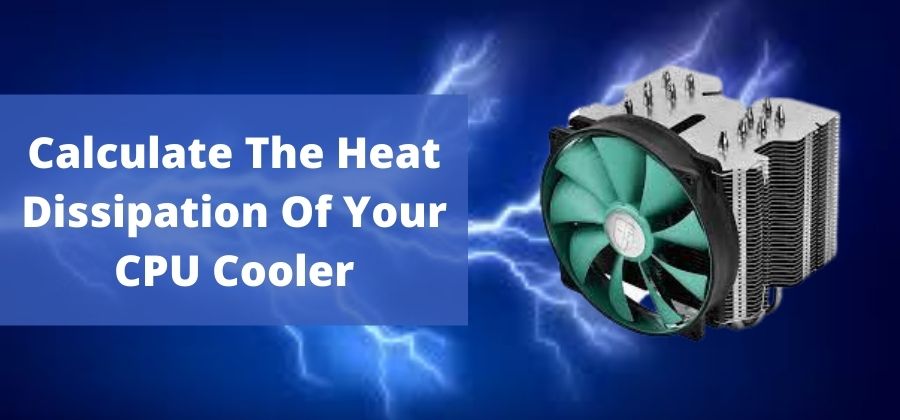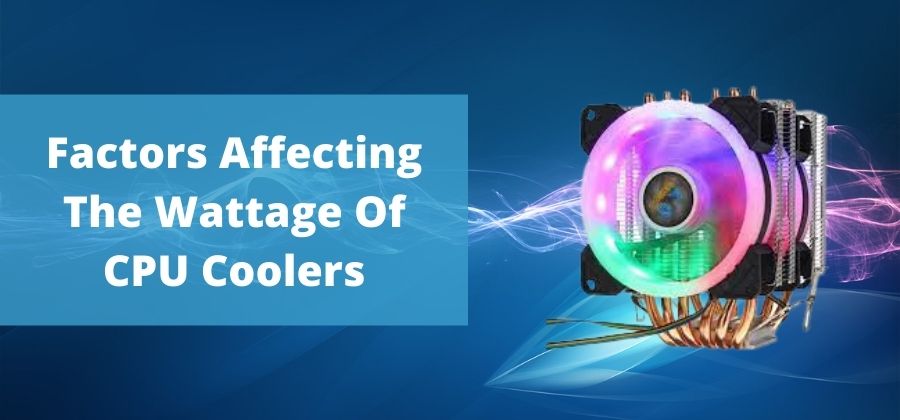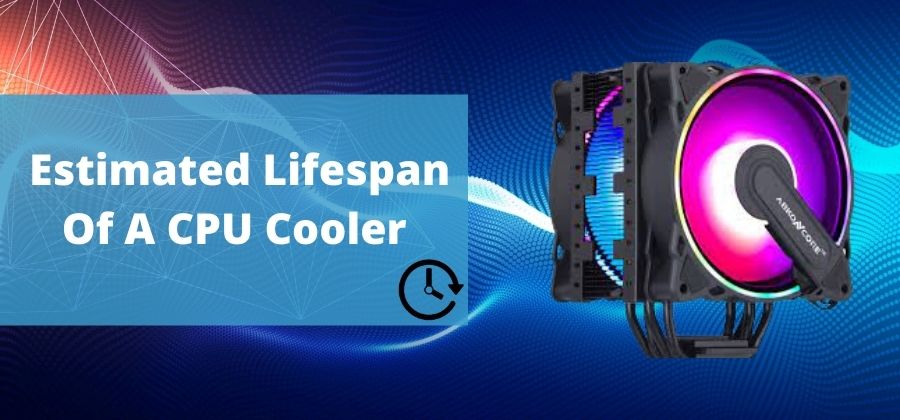Are you thinking to buy a PSU for your system? Or are you just curious to know how much energy a CPU cooler use. In either case you need to know how many Watts does a CPU Cooler use. now you must be thinking well that’s not a hard one because it might be already written on the box of your CPU cooler.
But is that even the actual power or not? Let us pop your bubble. No that isn’t the exact amount of power your CPU cooler uses. That is just a rough estimate and the actual power consumption depends on different components of your system.
How Many Watts Does A CPU Cooler Use?
Typically, a CPU fan cooler will use 1.8 watts of power and is rated at 12 volts. However, there are also larger fans that can use more watts.
There are other components involved which we will be talking about in detail in the coming sections.
Why Do I Need A CPU Cooler?
The best way to keep your CPU cool is to make sure that you have a good airflow system in place. The cooler is the final piece of the puzzle in ensuring that your computer’s internal components remain in good shape.
The right cooler will not only help keep your computer running at full capacity but will also help keep your system free from damage. A CPU cooler is a piece of hardware that helps keep your computer’s central processing unit (CPU) from overheating.
This is important because the hotter the processor, the more likely it is to become damaged or shut down. It can also lead to slower computer performance as well as other problems.
What Does TDP Of A CPU Cooler Mean?
It’s the maximum temperature a particular cooler can maintain. The cooler’s performance is measured on how effectively it moves air and how well it’s designed to conduct heat. The higher the TDP rating of the cooler, the more heat it can handle.
Depending on the model of your CPU, TDP can vary between 65W and 125W. The maximum power consumption of a CPU cooler is around 85 watts. The exact amount can be found on the manufacturer’s website or in the manual of the product you want to buy.
You’ll also see it printed on the cooler itself. However, you can use our power consumption charts to be sure about the maximum power consumption of your components. If you’re interested in knowing about power draw, check out the CPU cooler power consumption chart.
How To Know The Heat Dissipation Of A Cpu Cooler?
The heat dissipation of a CPU cooler is one of the most important factors when choosing a new cooler. TThe most important factor in choosing a cooler is the total heat dissipation you can expect your CPU cooler to provide.

Take the total number of watts (W) your system uses and divide that by the total number of watts your CPU cooler can dissipate. Your power consumption will be displayed in watts per degree Celsius.
What Size CPU Cooler Do I Need To Go For?
If you want to increase your computer’s cooling system’s performance, you need to ensure that the cooling system you purchase will fit your CPU perfectly.
CPU coolers are important in keeping your PC running cool. This means that it can make a difference in the noise and heat that your computer makes. Some all-in-one coolers are much louder than others.
What Factors Affect The Wattage Of CPU Coolers?
The number of watts a CPU cooler dissipates is directly proportional to the amount of heat it can transfer to the air. If you are looking for a CPU cooler that will keep your processor from overheating, it’s important to know how much wattage it takes to do its job. As a general rule, the more wattage a CPU cooler has, the better it will be at keeping your processor cool.

There are a few factors that affect the wattage of a CPU cooler. The size of the heatsink, the number of heat pipes, the number of fans, the fan speed, the RPM and the noise level are some of the determinants of the wattage.
What Is The Estimated Lifespan Of A CPU Cooler?
There are a number of factors that affect the wattage of a CPU cooler. Size, heat pipes, fans, fan speed, and rpm are just a few of the factors that can make a big difference. A good CPU cooler should have the right amount of wattage to ensure proper cooling.

For instance, if you’re looking for a CPU cooler that will keep your processor from overheating, it’s important to know what amount of wattage is needed to keep the processor working properly. As a general rule, the more wattage a CPU cooler has, the better it will be at keeping your processor cool.
Things To Consider While Buying A CPU Cooler
If you are planning to buy a CPU cooler for your computer, then it is to be noted that there are several factors to be considered.
Dimensions
The primary thing to consider when buying a cooler is the size of your case. If you have a larger case, it may not be possible to get a cooler that is too big.
However, if you don’t have a bigger case, then you may have a harder time finding a cooler that is the right size for your case. The best way to make sure that your cooler will fit in your case is to measure the dimensions of the case first.
Socket Compatibility
The socket that connects your CPU cooler to your motherboard. The socket is made for your CPU cooler, so you know it will fit. Make sure you get the socket you need before you buy your CPU cooler. The socket type is a really important consideration when you’re choosing the right cooler for your motherboard.
Different sockets require different cooling fans, and so you’ll need to pay attention to the socket type of your motherboard. There are also many different brands of CPU sockets, so you’ll need to be aware of the different types and brands to determine which one you have.
Cooling Capacity
A CPU cooler can be compared by the wattage that they can dissipate. The cooler that can dissipate more watts is better in terms of cooling efficiency. This is because of the heat that the cooler needs to dissipate.
Power needs to be factored in to cooling decisions. With lower numbers, the power requirements are lower but so is the efficiency of the unit. On the other hand, with higher numbers, the power requirements are higher but the efficiency is also higher.
Material Of The Heat-Sink
A heat sink is a device that transfers heat from one component to another. Heat sinks are also used in conjunction with other devices such as CPUs and GPU chips.
The fan-back of a CPU cooler has fins that direct the flow of air to the hottest part of the CPU (the processor).
Noise Level
Noise level of a CPU cooler is most often measured in decibels (dB). CPUs are designed to work within a certain temperature range, and if a processor is running too hot, it can overheat.
RGB
The RGB (Red, Green and Blue) colour scheme is used on monitors and computer displays to determine their appearance. It’s what determines whether a monitor is set to a bright and vibrant display or something that appears faded, dull and faded.
RGB lighting can be a great addition to a PC build, but it needs to be on the right motherboard and graphics card. If you’re not using an RGB capable motherboard and graphics card, then it’s not worth it to go with an RGB model.
Why It Is Important To Monitor The Wattage Of Your CPU Cooler?
A CPU cooler is among the most essential parts of your computer. That is the reason why you should choose it based on its wattage. However, there are a lot of coolers in the market and you need to be careful when choosing one.
There are some important features that you should consider before buying one. You should always know the wattage of your CPU cooler. This is because you have to take into consideration the amount of power your CPU cooler uses.
If the wattage of your cooler is too low, you will need to increase it. If the wattage is too high, then you will not be able to use your CPU cooler effectively. So, be wise while choosing one.
How To Maintain Your CPU Cooler?
It is a fact that, if you do not maintain your computer, it will not be in good condition. In the same way you must take care of your CPU cooler to make it last longer. You should check and clean the dust that accumulates on the fans and heat-sinks of your CPU cooler.
You can also remove the dust by cleaning your CPU cooler with a vacuum cleaner or a dust brush. It is also important to replace the fan blades when they get damaged. When cleaning, make sure you are not going too deep into the fins. You might damage the heat-sink or the CPU itself.
Conclusion
To sum it up a CPU cooler is as important as a motherboard or GPU or any other component of your system. Make sure you purchase a CPU cooler that is energy efficient but doesn’t compromise over its cooling action.
Hopefully this article has made clear how many watts does a CPU cooler use. We have also mentioned some of the handy factors that you need to consider while purchasing a CPU cooler. So, best of luck!